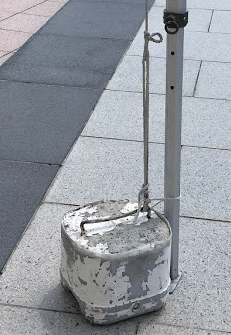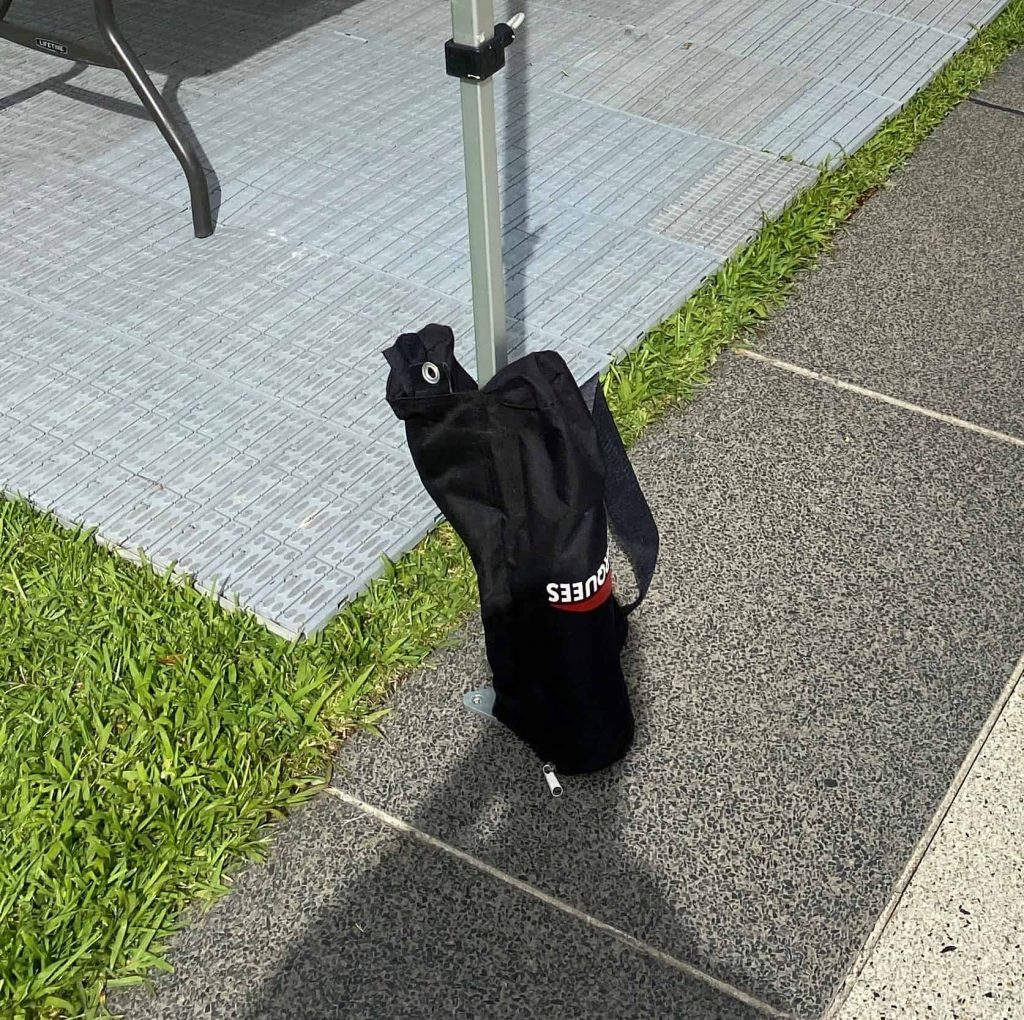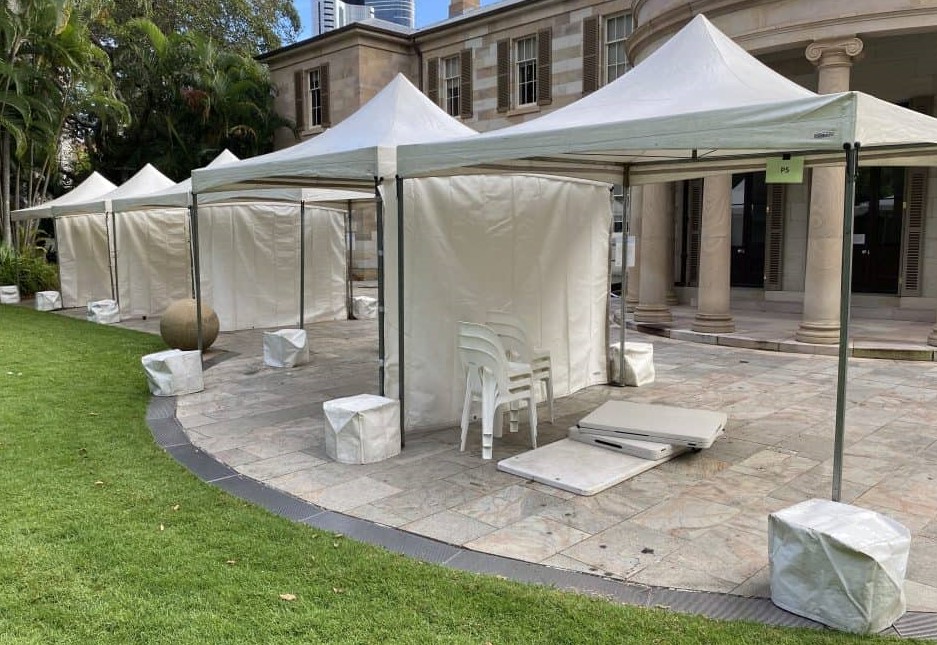Weighing down your canopy is one of the most common ways to prevent your pop up canopy taking off in a gust of wind. While it’s easy to find and even make tent ballasts, knowing how much weight you need to hold down a 10×10 canopy is not always clear. Not many canopy tents come with an official wind certification and weight rating, but there are some general guidelines to help land you in the right ball park.
How much weight do you need to hold down a pop up canopy / gazebo?
This will depend on a few factors including wind speed, canopy weight and design, and ground conditions. In the first case check with the manufacturer of your canopy; sometimes they will publish/tell you what their equipment has been certified for. As a rule of thumb, for a 10x10ft (3x3m) canopy in mild conditions, would be to weigh down each leg with around 45-65 pounds (20-30kg). If stronger wind conditions are expected, or if your pop up canopy is bigger, consider doubling the weight. If high winds are expected do not use your canopy.
If you are setting up your canopy as a stall, you may be provided with some minimum weight guidelines from the marketplace organisers.
Types of canopy tent weights
There are a large range of different types of weights to hold down your canopy. These can be separated into blocks, plates, bags and drums; and all of these types have DIY options.
Concrete block weights
If you do a lot of events, and generally in the same location (eg. market stall), then it may make sense to invest in concrete blocks. The downside of using these is that they are hard to transport and handle – you’ll need a vehicle or heavy-duty trolley to move them around. However, the good thing is that they are always ready to go, and will last you a long time. Bare concrete can look a little crude, so you might want to cover or hide them.

Weight plates
Weight plates (see photo below) are better looking and more user friendly than concrete blocks. The advantage of buying purpose-built leg weights is that they are molded to slot into a pop up canopy leg. There are various designs but most commonly these look like metal or plastic ‘Pacman’ plates that fit around the canopy’s feet, and are able to be stacked to tailor the weight to the conditions.
Tent weights are a great because they come in manageable weight loads; so you can add or remove weight depending on conditions, and move them around with more ease compared to a block of concrete. They are still not something you want to carry with you to setup a canopy at the beach, or in the local park. You’ll see these used in permanent/semi-permanent event spaces like market places or sports grounds, where a stash of weight plates can be kept locally.
Water drums
You can buy drums or containers that are molded to fit around the feet of your canopy, which you can then fill with water as a ballast. They are still a portable option as they are light when you empty them, however they still take up more room than weight-bags. Water drums are particularly useful when you need a portable ballast option and you have a reliable water source, but don’t have access to filler materials to use a weight bag. You’ll see water drums used at events that are rarely held in the same location, as they can be easily ‘bumped’ in and out in their unfilled state (see photo below).

Weight bags / sandbags
Tent weight bags are a great product to accompany your pop up canopy as they are lightweight and portable. Store them with your canopy, and you’ll have an easy anchoring option anywhere you go. There are a heap of different designs, but most feature a strong polyester or canvas bag that you fill with ‘heavy stuff’ (eg. sand, gravel or whatever you have onsite) and velcro or tie to the canopy. [insert photo of tent bag).
Sand bags are obviously not as robust as concrete or weight plates, and probably not the best option to leave out in the weather. To take advantage of their portability, you need to have access to the filler onsite (eg. using sand at the beach). Otherwise you’ll be dragging the heavy filler with you, in which case you may as well use weight plates.

DIY Canopy weights
If you are setting up a canopy for regular sustained periods (e.g. market stall) it may be beneficial to make a more permanent leg weight solution that you can use again and again. A very simple option is to pour concrete into a plastic container.
A neater option is to pour concrete into a length of PVC pipe, allowing for a hook to be set-in at one end. This makes fairly cheap and smart looking weights that you paint to color match your canopy tent – perfect for market stall setups. Check out this step by step video by Chad Schimmel.
You can also fill common household items like buckets, milk/juice jugs or painting cans with heavy fill like sand, gravel or water.
Store-bought vs homemade canopy weights
It’s very easy to make homemade canopy weights, and they will perform very similar to store-bought. The main point of difference is in the appearance of your ballast, and portability. Unless you have some design skills, your homemade option won’t look as snazzy as something off the shelf. If you need to constantly move your canopy around, you will be hard placed to make something as well engineered to be portable and easy to use.
Conclusion
The manufacturers manual is the best place to find out how much weight to hold down aa 10×10 canopy, as it may have been certified to a certain wind rating. If you don’t have that information, then a good rule of thumb is to weigh down each leg with around 45-65 pounds (20-30kg). If stronger wind conditions are expected, or if your pop up canopy is bigger, consider doubling the weight. If high winds are expected do not use your canopy. The main type of pop up canopy weights are weight blocks, plates, bags, and drums; and all of which can be homemade.

